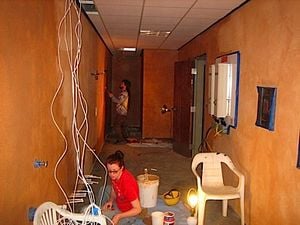
Flour paint is one of the most versatile paint types and can be used inside or outside, on wood, stone, drywall, wallpaper, earthen and gypsum plaster, masonry and to cover existing painted surfaces. This paint is very thick and can destroy brushes, but the recipe can be tweaked a little to achieve different textures. Flour paint typically consists of water, flour, colored clay and more uncolored clay filler.[1]
See CCAT natural paint project#Flour Paint for a project that used this Natural paint.
Recipe[edit | edit source]
| Ingredient | Amount |
|---|---|
| Clay (sifted) | 1 Cup |
| Filler (e.g. mica) | 1/2 Cup |
| Flour | 1 Cup |
| Cold water | 4 Cups |
| Boiling water | 1.5 Cups |
| Pigment (slaked) | as needed |
| coverage approximately 72 square feet | |
Directions[edit | edit source]
- Mix the clay and filler in a bowl and set aside.
- In a separate bowl, mix the flour with the 2 cups of water. In a pot boil 1.5 cups of water. Once boiling add the flour and water paste to the boiling water and turn the temperature down to low. Continuously stir until the mixture becomes a thick paste. This will take some time, be patient or the paint will not come out right.
- Next, remove the mixture from the heat and slowly mix in the 2 cups of cold water.
- Pour the flour and water mixture into its final container and add the clay and filler mixture. Mix very well.
- Add pigment, if desired, until the desired color is reached. If you decide to use pigment only add a little at a time because a little goes a long way and once its in you can't take it out.
- Making the Paint
-
Mix clay and mica in separate container
-
Heat flour mixture into a paste
-
Dump paste into larger bucket
-
Add dry mixture slowly
-
Add pigment
Properties of Flour Paint[edit | edit source]
Flour paint is not water resistant and for that reason should not be used in areas with high water usage such as kitchens or bathrooms. Water is the solvent in flour paint. Water suspends the other ingredients and is what makes flour paint spreadable. Once the flour paint dries on a surface the water evaporates leaving behind the other ingredients. If water is reintroduced, the other ingredients resuspend making is spreadable again. This can leave drip marks and discoloration. Flour paint is not washable because it is not water resistant. Also flour paint does not have any type of antibacterial agent added, so continuous exposure to water can make the wall prone to mold, fungi and bacteria.
Flour paint is however useful in areas not prone to water exposure. Some advantages to flour paint are: simplicity, longevity, compostability, time, cost, and versatility. Flour paint is easy to make and easy to use. It also does not require refrigeration, if kept in a cool dry spot it can last for days. Flour paint (as we have described it) can be composted. It doesn't take very long to make (compared to Quark and Borax paint). It is also inexpensive, especially if using local materials or materials found at home (such as clay from the yard). Flour paint is also versatile. Any kind of flour, clay or filler can substituted. We choose mica as a filler because it gives a shimmering effect, but straw, sand, or more clay could be used instead.
See also[edit | edit source]
References[edit | edit source]
- ↑ Steen, B., (2006). "Make Safe, Natural Paint." Mother Earth News (218), http://www.motherearthnews.com/DIY/2006-10-01/Make_Safe_Natural_Paint.aspx [accessed 2/3/2007].




